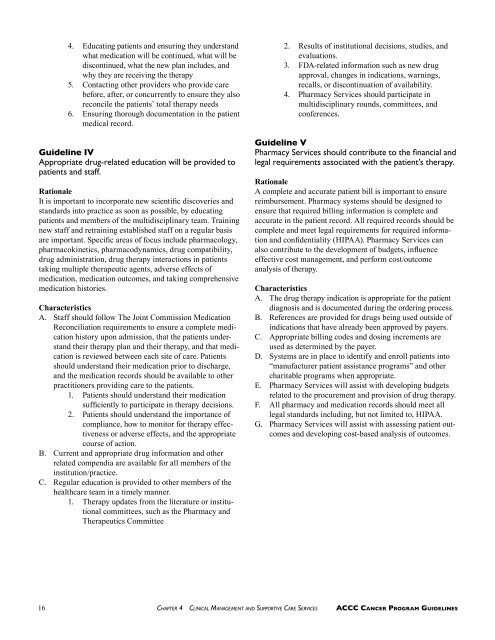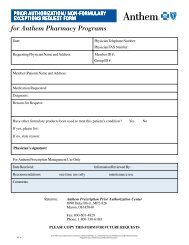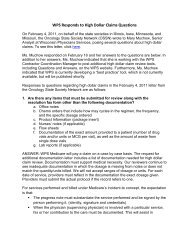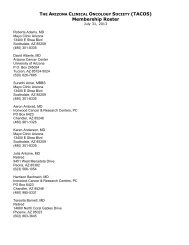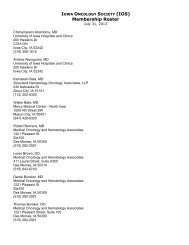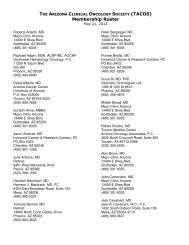Cancer Program Guidelines - Association of Community Cancer ...
Cancer Program Guidelines - Association of Community Cancer ...
Cancer Program Guidelines - Association of Community Cancer ...
Create successful ePaper yourself
Turn your PDF publications into a flip-book with our unique Google optimized e-Paper software.
4. Educating patients and ensuring they understand<br />
what medication will be continued, what will be<br />
discontinued, what the new plan includes, and<br />
why they are receiving the therapy<br />
5. Contacting other providers who provide care<br />
before, after, or concurrently to ensure they also<br />
reconcile the patients’ total therapy needs<br />
6. Ensuring thorough documentation in the patient<br />
medical record.<br />
Guideline IV<br />
Appropriate drug-related education will be provided to<br />
patients and staff.<br />
Rationale<br />
It is important to incorporate new scientific discoveries and<br />
standards into practice as soon as possible, by educating<br />
patients and members <strong>of</strong> the multidisciplinary team. Training<br />
new staff and retraining established staff on a regular basis<br />
are important. Specific areas <strong>of</strong> focus include pharmacology,<br />
pharmacokinetics, pharmacodynamics, drug compatibility,<br />
drug administration, drug therapy interactions in patients<br />
taking multiple therapeutic agents, adverse effects <strong>of</strong><br />
medication, medication outcomes, and taking comprehensive<br />
medication histories.<br />
Characteristics<br />
A. Staff should follow The Joint Commission Medication<br />
Reconciliation requirements to ensure a complete medication<br />
history upon admission, that the patients understand<br />
their therapy plan and their therapy, and that medication<br />
is reviewed between each site <strong>of</strong> care. Patients<br />
should understand their medication prior to discharge,<br />
and the medication records should be available to other<br />
practitioners providing care to the patients.<br />
1. Patients should understand their medication<br />
sufficiently to participate in therapy decisions.<br />
2. Patients should understand the importance <strong>of</strong><br />
compliance, how to monitor for therapy effectiveness<br />
or adverse effects, and the appropriate<br />
course <strong>of</strong> action.<br />
B. Current and appropriate drug information and other<br />
related compendia are available for all members <strong>of</strong> the<br />
institution/practice.<br />
C. Regular education is provided to other members <strong>of</strong> the<br />
healthcare team in a timely manner.<br />
1. Therapy updates from the literature or institutional<br />
committees, such as the Pharmacy and<br />
Therapeutics Committee<br />
2. Results <strong>of</strong> institutional decisions, studies, and<br />
evaluations.<br />
3. FDA-related information such as new drug<br />
approval, changes in indications, warnings,<br />
recalls, or discontinuation <strong>of</strong> availability.<br />
4. Pharmacy Services should participate in<br />
multidisciplinary rounds, committees, and<br />
conferences.<br />
Guideline V<br />
Pharmacy Services should contribute to the financial and<br />
legal requirements associated with the patient’s therapy.<br />
Rationale<br />
A complete and accurate patient bill is important to ensure<br />
reimbursement. Pharmacy systems should be designed to<br />
ensure that required billing information is complete and<br />
accurate in the patient record. All required records should be<br />
complete and meet legal requirements for required information<br />
and confidentiality (HIPAA). Pharmacy Services can<br />
also contribute to the development <strong>of</strong> budgets, influence<br />
effective cost management, and perform cost/outcome<br />
analysis <strong>of</strong> therapy.<br />
Characteristics<br />
A. The drug therapy indication is appropriate for the patient<br />
diagnosis and is documented during the ordering process.<br />
B. References are provided for drugs being used outside <strong>of</strong><br />
indications that have already been approved by payers.<br />
C. Appropriate billing codes and dosing increments are<br />
used as determined by the payer.<br />
D. Systems are in place to identify and enroll patients into<br />
“manufacturer patient assistance programs” and other<br />
charitable programs when appropriate.<br />
E. Pharmacy Services will assist with developing budgets<br />
related to the procurement and provision <strong>of</strong> drug therapy.<br />
F. All pharmacy and medication records should meet all<br />
legal standards including, but not limited to, HIPAA.<br />
G. Pharmacy Services will assist with assessing patient outcomes<br />
and developing cost-based analysis <strong>of</strong> outcomes.<br />
16 Chapter 4 Clinical Management and Supportive Care Services ACCC <strong>Cancer</strong> <strong>Program</strong> <strong>Guidelines</strong>


